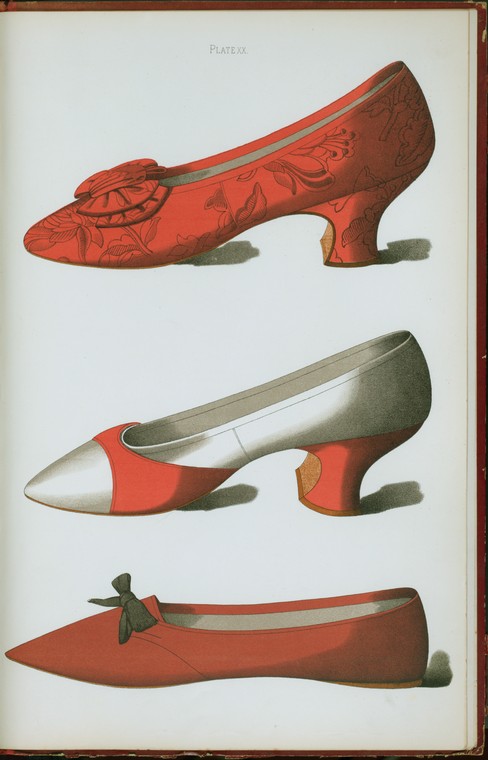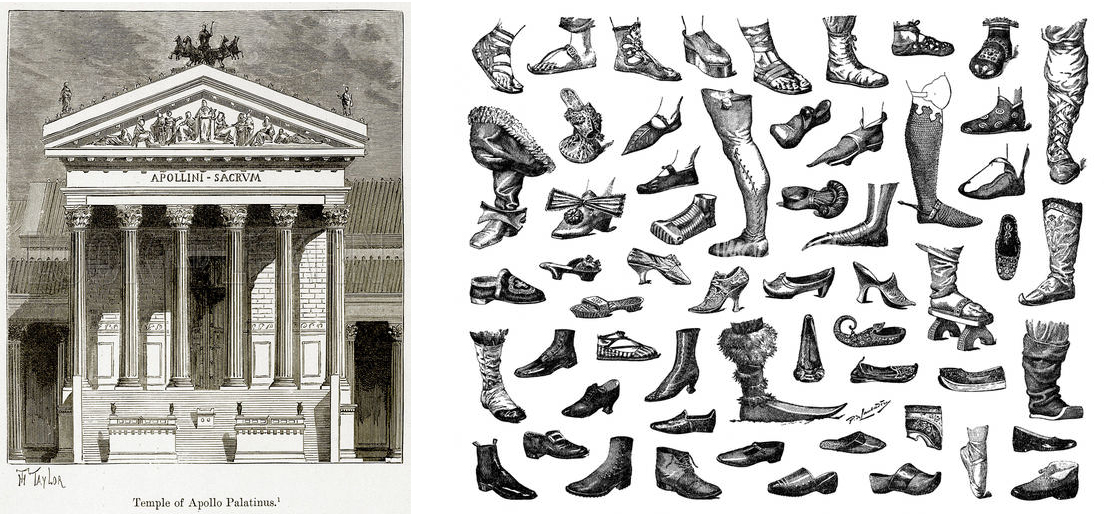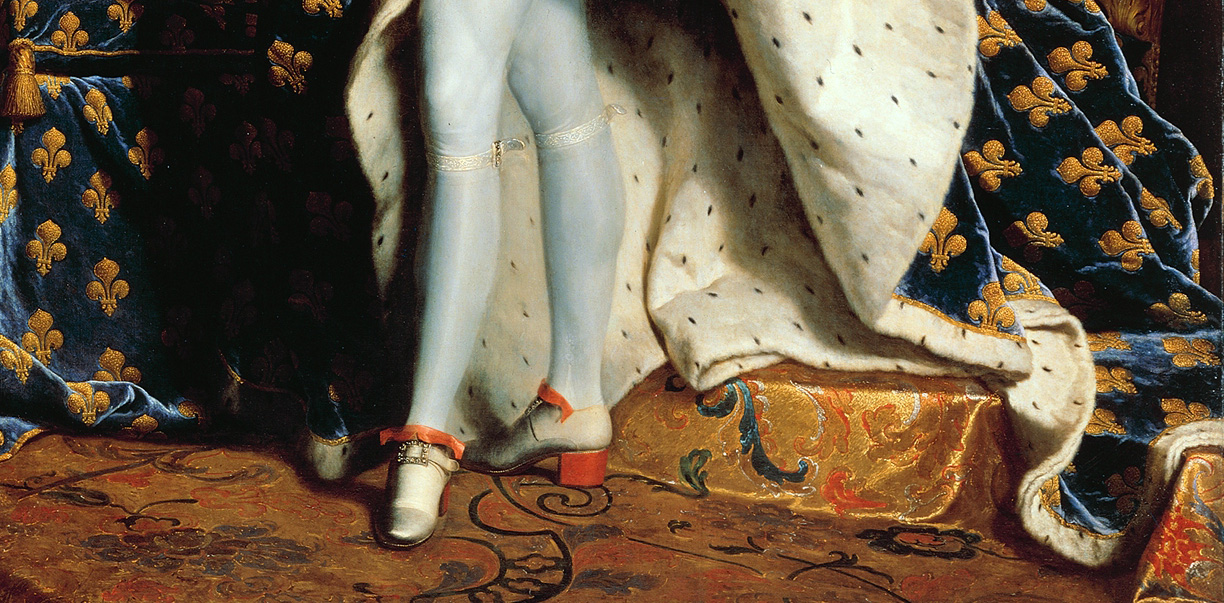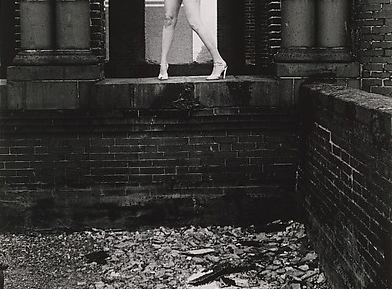“The more simply and essentially the shoe-equipment is absorbed in its essence […] the more immediately and engagingly do all things become, along with them, more in being. In this way, self concealing becomes illuminated. Light of this kind sets its shining into the work. The shining that is set into the work is beautiful.” 1
B
oth footwear and architectural foundations share signification as functional, survivalist structures simultaneously interpreted as humanist and divine. This juxtaposition inspired unique forms of each — namely, the elevated foundation of Ancient Greek temples and the high-heeled shoe — that lift the terrestrial into a divine realm. While architecture emanated from a necessity for sanctuary, and footwear from a requirement for increased mobility, their rudimentary functions can be understood as extensions of our bodies’ capabilities: the shoe hardens the sole and the buildings expand the structure of the body. In The Temple In the House, Anthony Lawlor expresses this resemblance as the essence of architecture:
“A building’s structural system is […] engineered to balance contractive and expansive forces. This condition is reflected in our skeletal and muscular system. The bones of the feet spread out to create a platform that upholds the rest of the body. The legs act as two pillars, extending away from the earth’s gravitational pull. The pelvis serves as a crossbeam, which in turn supports the spinal column. The shoulder blades act as another beam, supporting the neck and head. The dome-like structure of the skull recalls the span of the roof.” 2
This analogy represents the mutual origin of shoes and dwellings as life-support systems extending “the stream of inner intelligence that flows through the body into structural elements.” 3
In later centuries, both footwear and architecture garnered iconographic representations of the sacred. In antiquity, the “new” Greek temple first appeared as an actively geometric container with a high, upward-thrusting gable.4 Its base acted as the critical sacred lever allowing the temple to rise out of the ground and, as if inevitably, lifting the columns and surrounding structure out of the profane and into the sacred. Scully writes, “The whole rises, and the word here must be rises, out of the ground, rises upon a stepped base, which is itself swelling upward also, so that one force is acting through the whole”.5 The effect can be dramatic; the temple of Apollo is elevated so elaborately from the earth that the remaining void seems to drop off from the columns, and suddenly the mountains and earth come in close proximity to the viewer. 6
This effect is not limited to upward movement. Greek amphitheaters descended into the earth, offering a more secular communal effect. “Where the temple on the hill rose to a unique point of singularity, the amphitheater drew diverse people together in an experience of communal unity.” The base, through the act of raising or lowering a sacred whole, fundamentally signifies the ascent and descent of the spirit. 7
Historical texts serve as support for the symbolic function of footwear, with the heel in particular acting as a stand-alone sacred lever. In ancient Greece and parts of Africa, sumptuary laws forbade lower class citizens from wearing ornamental footwear, or even from wearing footwear at all. 8 The elevated heel was limited to members of the upper class, who were thought to have adorned this style to make apparent their wealth and status as divine beings.9 Within the Ottoman Empire, platform stilts known as kabkabs were worn by upper-class women. In Japan, the geta — a sandal resting upon stilts — was worn solely by emperors and priests. 10 The introduction of the heel into Western culture in the 13th-century is also attributed to a sacred elite; the horseback riding Persians and Mongols of Central and Eastern Asia likely introduced these forms to the French during the Crusades. 11
In The Origin of the Work of Art, Heidegger defines the elusive sacredness of objects as an object’s “thingliness”. 12 This essence, Heidegger argues, is greater than the “equipmentality” of the object and its given form, greater than the collection of an object’s properties, and greater still than the sum of our many perceptions of the object in question. It is instead best understood as a self-sufficient quality that precedes the object, and from which the aforementioned properties are birthed. 13 What renders objects as sacred symbols is the exposure of a truth inherent to the object itself.
The presumption of preexistent sacred form is apparent in our understanding of Ancient Greek temples. Influenced by monumental dipylon jars of the same period, these temples were initially constructed with the purpose of containing a deity already present at the site in which these temples were built. Says Vincent Scully in The Earth, the Temple, and The Gods:
“[…] we must […] recognize that, not only were certain landscapes indeed regarded by the Greeks as holy and as expressive of specific gods, or rather as embodiments of their presence, but also that the temples and subsidiary buildings of their sanctuaries were so formed in themselves and so placed in relation to the landscape and to each other as to enhance, develop, complement, and sometimes even to contradict, the basic meaning that was felt in the land.” 14
Historical accounts of footwear are indicative of the same conception. Ancient Assyrian reliefs consistently show feet as placed firmly on the ground, reconciling the mobility of man with a need to belong to and be continuous with the spiritual space of the Earth. 15 The display of shoes of Holocaust victims in the United States Holocaust Museum is an evocative contemporary example of the powerful symbolism of shoes as the representations of sacred bodies. Says Shari Benstock in Footnotes on Shoes, “we envision the shoes attached to bodies that we ourselves invent to complete the effect. As such, [they] accrue a moral power.” 16
The ever-present tension inherent between human constructs and the essential godly force contained within is precisely what allows for the exposition of sacredness, or what Heidegger calls “truth in action.” Heidegger compares this revelation to the cyclical ascent and descent of water out of and back into the basin of a Roman fountain; the sacred and the humane are understood in relation to each other, each revealing and raising the other into self-assertion. Scully’s depiction of ancient Greek temples mirrors this understanding. According to Scully, the new temple for the first time begins to reveal and simultaneously reconcile oppositions between man and god, representing to all men, “the presence of a god and [being] itself the monument of that presence.” The temple is simultaneously representative of the earth and free from it, a “true personality and force.” 17 Heidegger describes this phenomenon in detail:
“Standing there, the building rests on rocky ground. This resting of the work draws out of the rock the darkness of its unstructured yet unforced support. Standing there, the building holds its place against the storm raging above it and so first makes the storm visible in its violence. The gleam and luster of the stone, though apparently there only by the grace of the sun, brings forth the light of day the breadth of the sky the darkness of the night. The temple’s firm towering makes visible the invisible space of the air. The steadfastness of the work stands out against the surge of the tide and, in it’s own repose, brings out the raging of the surf.” 18
It is important to note that the foundational element of the whole of the temple — the elevated base — serves no functional purpose whatsoever. In The Origins of Greek Architectural Orders, Barbara Barletta mistakenly interprets these bases as ornamental:
“In Doric architecture, the structural role played by bases will be assumed later by a continuous stylobate,” although separate bases still appear in the seventh century, as already noted in the temple at Ano Mazaraki. […] because the stylobate alone would have been sufficient to elevate and thus protect the wooden supports, this combination [in Doric architecture] must be understood as decorative.” 19
The base is instead an element that makes possible Heidegger’s “truth in action,” allowing the sacred to be represented by the temple; it is a free-standing agent of the sacred act.
This point can be comparatively understood through an analysis of high heels in footwear. Though existing in antiquity, it is only after the shoe begins to “unconceal” the sacred human body does the high heel began to emerge as an almost autonomous vestigial element of the shoe — a true independent form that continues to coexist with footwear today. 20 The impact of the high heel on sacred form was most clearly made apparent by Louis XIII and Louis XIV, both of whom wore high heels with the specific intention of elongating and creating gracefulness in their heavy bodies. 21 The result was considerable: standing in heels was shown to elongate the leg, raise the buttocks, curve the back, and push the chest forward. When worn by women, the effect is even more pronounced by effectively doubling a woman’s middle pelvic angle. Walking in heels further exaggerates the motion of hips, accentuates curves, and feminizes the gait by shortening the stride and causing a mincing step. 22
Like Barletta’s assessment of the elevated base, the high heel was labeled by some as ornamental, and not thought to endure. Adolf Loos dismisses the high heel as an arbitrarily ornamental relic of a more primitive feminine fashion. For Loos, the coquette, the prostitute, the demimondaine led the way in a woman’s dress 23, but their fashion would quickly lose influence as women gained greater equality to men. He writes:
“We are approaching a new and greater time. No longer by an appeal to sensuality, but rather by economic independence earned through work will the women bring about her equal status with man. The woman’s value or lack of value will no longer fall or rise with the fluctuation of sensuality. Then velvet and silk, flowers and ribbons, feathers and paints will fail to have their effect. They will disappear.” 24
Loos, like Barletta, overlooks the powerful ability of the form to reveal the sacred body, an effect so profound that heels maintained in popularity well past the French Revolution — a time when many “elite” ornaments were discarded as symbolic of aristocracy — through the women’s rights movement of the 20th century and onward, despite the significant discomfort they inflict upon the body. 25
In “The Modern Foot,” Lyons understands this phenomenon in much the same way as Heidegger’s theory of “truth in action.”
“Instead of framing the shoe as in a functionalist narrative—a narrative about the shoe-as-protection, or the shoe-as-replacement/fetish, or the shoe-as-commodity, we ought to consider the shoe (the fabulous shoe, at least) as a thrilling response to the ambivalence of modernity, to its relentless shuffle between liberation and discipline. For if, as sociologists of modernity have argued, modernity itself is constituted by the tension between the liberating forces of modern autonomy and the restraining forces of modern disciplinary governance, then surely we must be able to identify cultural artifacts products by that conundrum. The fabulous shoe, I would argue, is one of them.” 26
Like the base of a temple, the heel acts to both reveal and reconcile oppositions between a disciplinary entity and an expression of liberation, reflecting the strife existent between an expansive world and the earth upon which the world is grounded.
LINA SHAHHAL
NOTES
1 Heidegger 32
2 Lawlor 109
3 Lawlor 103
4 Scully 43
5 Scully 63
6 Scully 177
7 Lawlor 81
8 DeMello 310
9 DeMello 158
10 DeMello 75
11 DeMello 158
12 Heidegger 4
13 Heidegger 10
14 Scully 3
15 Bondi 49
16 Benstock 9
17 Scully 44
18 Heidegger 41
19 Barletta 47
20 Bondi 168
21 DeMello 168
22 Benstock 10
23 McLeod 6
24 Loos 70
25 DeMello 159
26 Lyons 279
PLATES
2 Temple of Apollo, Palatinus. Illustration from “History of Rome” by Victor Duruy (Kegan Paul, Trench & Co, 1884).
3 Shoe Designs, Unknown Origin
4 Louis the XIV of France, Hyacinth Rigaud, 1701. Public Domain.
5 Hannah Wilke, So Help Me Hannah: Snatch-shots with Ray Guns, 1978. Gelatin silver print; Image: 33.1 x 21.8 cm (13 1/16 x 8 9/16 in.) Sheet: 35.4 x 28 cm (13 15/16 x 11 in.) The Metropolitan Museum of Art, New York, Purchase, The Buddy Taub Foundation Gift, Dennis A. Roach and Jill Roach, Directors, 2010 (2010.353) http://www.metmuseum.org/Collections/search-the-collections/294414.
BIBLIOGRAPHY
1. Barletta, B. (2001). The Origins of the Greek Architectural Orders. London: Cambridge
University Press.
2. Benstock, S & Ferris S. Footnotes on Shoes. London: Rutgers University Press.
3. Bondi, F & Mariacher, G. (1983). If The Shoe Fits. Italy: Cavallino.
4. Canon, J. Sacred Spaces: Decoding Churches, Cathedrals, Temples, Mosques and Other Places of Worship Around the World. (2013). London: Watkins Publishing
5. Corbusier, L. (1923). Vers Une Architecture. (1923). New York: Dover Publications.
6. DeMello, M. (2009). Feet and Footwear: A Cultural Encyclopedia. Oxford: Greenwood Press.
7. Heidegger, M. The Origin of the Work of Art. In Heidegger, M. Off the Beaten Track (pp.156)
8. Lawlor, A. (1994). The Temple in the House: Finding the Sacred in Everyday Architecture New York: G.P. Putnam’s Sons.
9. Loos, A. (2011). Adolf Loos: Why A Man Should Be Well-Dressed. Vienna: Metroverlag.
10. Lyon, J (2011).The Modern Foot. In Benstock, S & Ferris S (Eds.) Footnotes on Shoes. (272-281). London: Rutgers University Press
11. McLeod, M. Undressing Architecture. Fashion, Gender, and Modernity. In Fausch D., Architecture in Fashion (pp. 39-123). New York: Princeton Architectural Press.
12. Mumford, L. (1952) Art and Technics. Oxford: Oxford University Press.
13. Scully, V. (1962). The Earth, The Temple, and the Gods. New Haven and London: Yale University Press.




